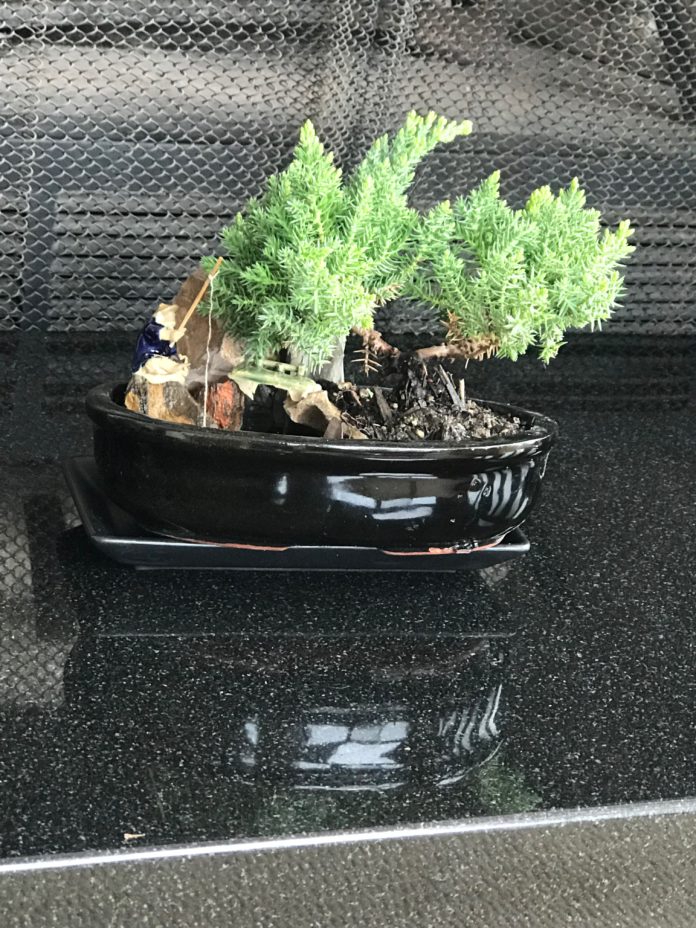Beautiful Bonsai
On the last day of February, I missed the meeting I most wanted to attend. Fortunately, Martha Pehl stood in for me taking great notes as Abe Far, president of the Golden State Bonsai Federation made his presentation. I am probably the last person to write about Bonsai. My father had one, but he also had a Japanese gardener to care for it. My mother purchased the pot in Japan with money she had earned on jury duty. Daddy had the gardener plant it. By the time I inherited it, the bonsai was well over 40 years old. It took me about a year to kill it.
Even though I disclosed my failure to help a bonsai to thrive, a friend asked me to “foster” hers as she was moving to Colorado and couldn’t take it with her. Reluctantly I agreed. Each time she came for a visit, it looked a little worse. After three years, it was hanging to life by a thread. I did not want it to die on my shift, so she carried it back to Colorado. . . maybe on her lap in the plane. It died the following year, but not on my shift.
According to Abe Far, succeeding with bonsai means you should have a passion, patience, and knowledge of its history. I did a bit of investigation and learned that bonsai came to Japan from China as religious souvenirs at least twelve hundred years ago. The bonsai is a tree that is “fashioned (by human beings) with loving care that its shape and style acquire the ability to move one.” Tray landscapes were developed by Zen monks so that a single tree in a pot could represent the universe. Eventually even ordinary peasants grew some small form of tree or azalea in a small pot or shell.
By the 1800s, these miniature landscapes, renamed Bonsai, had become a craft, and design became more important than a religious endeavor. As the years passed, more and more countries became fascinated by Bonsais. Bonsai arrived in the United States after World War II. Today there are more than 1200 books about Bonsai and related arts in 26 languages.
Far advocates knowing the plant you are choosing. This includes knowing how it grows and what its needs are. The trunk is most important. You can alter the branches, but the trunk is harder to change. Decide if you want a tree that will be upright, grow on a slant, or cascade. The pot you choose should have a drain hole. It need not be very deep, but do consider its size in relation to your plant.
Next prepare your bonsai. Water it before you plant it. Abe uses chopsticks to remove soil from the roots. He also removes about two-thirds of the roots including the tap root.
To get the pot ready, combine small gravel, humus, clay and ten per cent organic soil (such as cactus mix). Next place your bonsai in the pot. Spread its roots out. Then slip a small gauge wire through one of the drainage holes, and tie the wire to the trunk. This will help to support the tree as it grows.
For the first week, keep the tree in shade. Slowly introduce it to more sunlight. Because the pot is small, you should water your plant daily using tepid water. Feed your tree once a month using a very diluted fertilizer. Spring is the best time to plant or re-pot since that is when growth is most vigorous. Twice a year you should sprinkle gypsum on the soil. This helps clean the roots. Every other year you should re-pot your plant after trimming the roots and foliage. Always use new soil.
To make your plant grow into the shape you want, shape branches downward for an upright tree. Do consider the way the tree grows in the open. The trunk should be straight, tapering naturally and evenly. Branches should be symmetrically spaced so the tree looks the same from any view. Junipers and pines work well. If you want an informal upright, be certain the tree does not bend towards the viewer. Neither trunk nor branches should point toward the front. Slanting shapes occur from winds or deep shade in the plant’s early years. The trunk leans at an angle with the roots growing out the other side of the direction the trunk leans. This supports its weight. You can either plant the tree at a slant or wire its trunk so it leans.
After you trim your branches, shape them using copper or aluminum wire, which you twist gently, not tight. Bend the branch gently to the desired shape. “Always use good tools!” warns Far.
The number three is important. The lowest branches should be grouped in threes starting one-third up the trunk. The bottom three encircle the trunk. The branches can thrust forward with one slightly higher than the other.
Another design pointer is to keep your plant small. Give it the right soil, the proper fertilizer and sunlight. In addition, trim off the tap root but keep the hairy ones. Newly planted bonsais should spend the first week in shade. Gradually introduce them to sunlight.
Definitely look at more specific directions either on line or in books. I am tempted to make another stab it this, but it is a bit like getting a puppy or kitten: constant attention, rewarding but requires work.
The May 30 Mission Hills Garden Club meeting is from 6 to 8 p.m. at the Mission Hills Church of Christ at 4070 Jackdaw and will feature Danica Hirsch, who specializes in creating artfully mixed containers and garden pieces using a variety of plants and materials. She will show us how to add interest and beauty to our gardens.

Category: Education, Featured Articles, Local News







